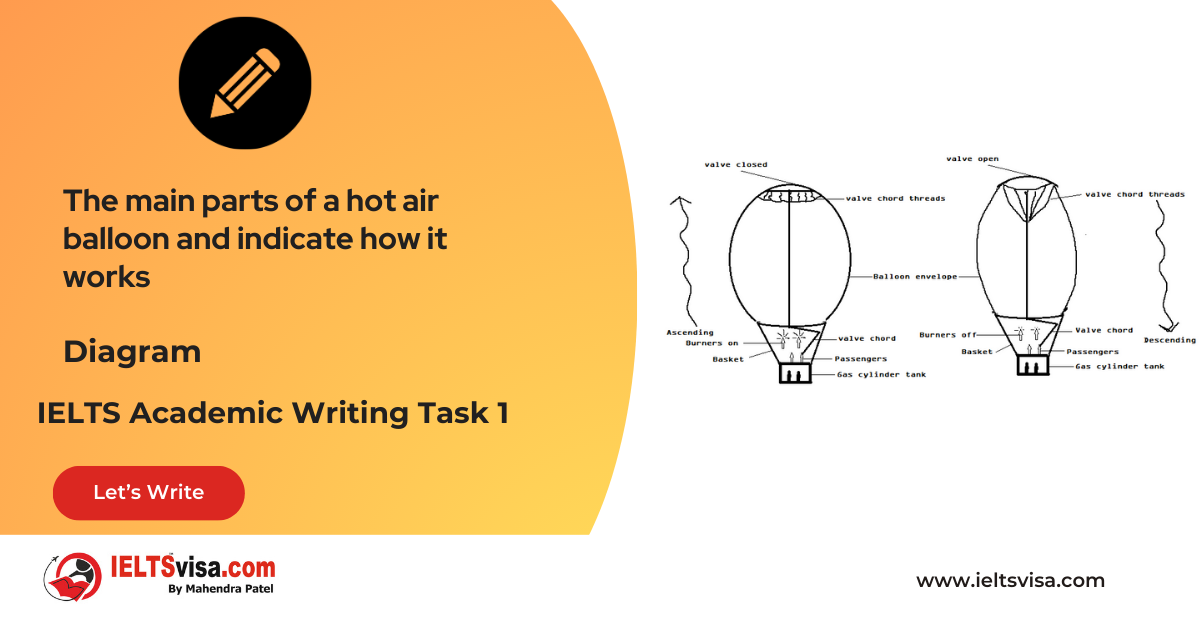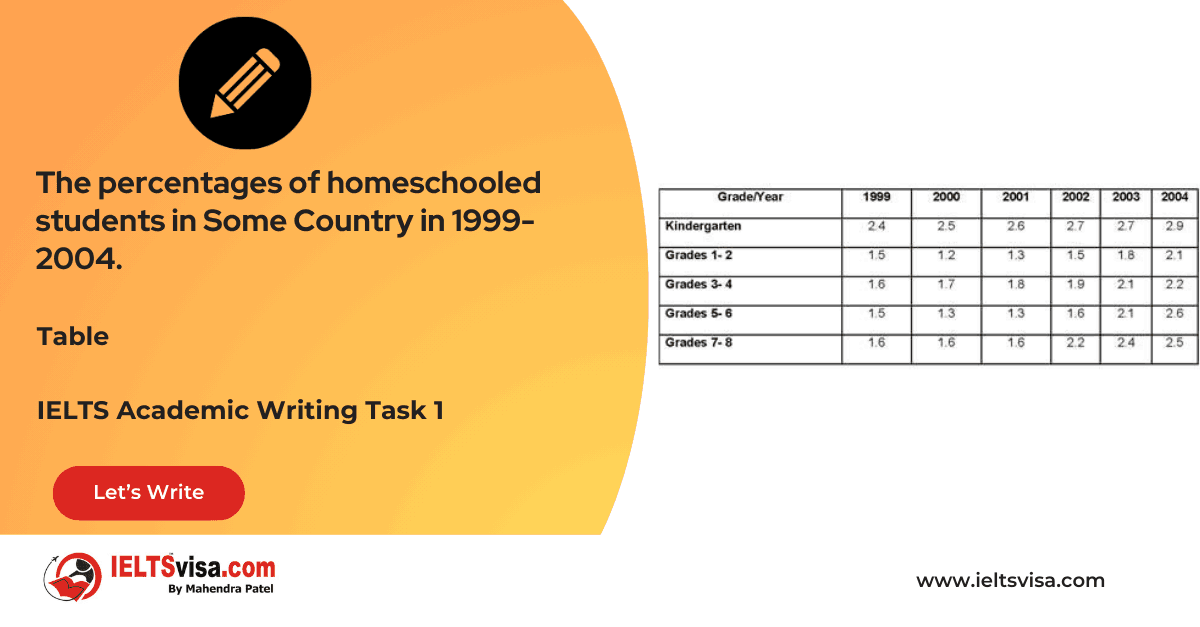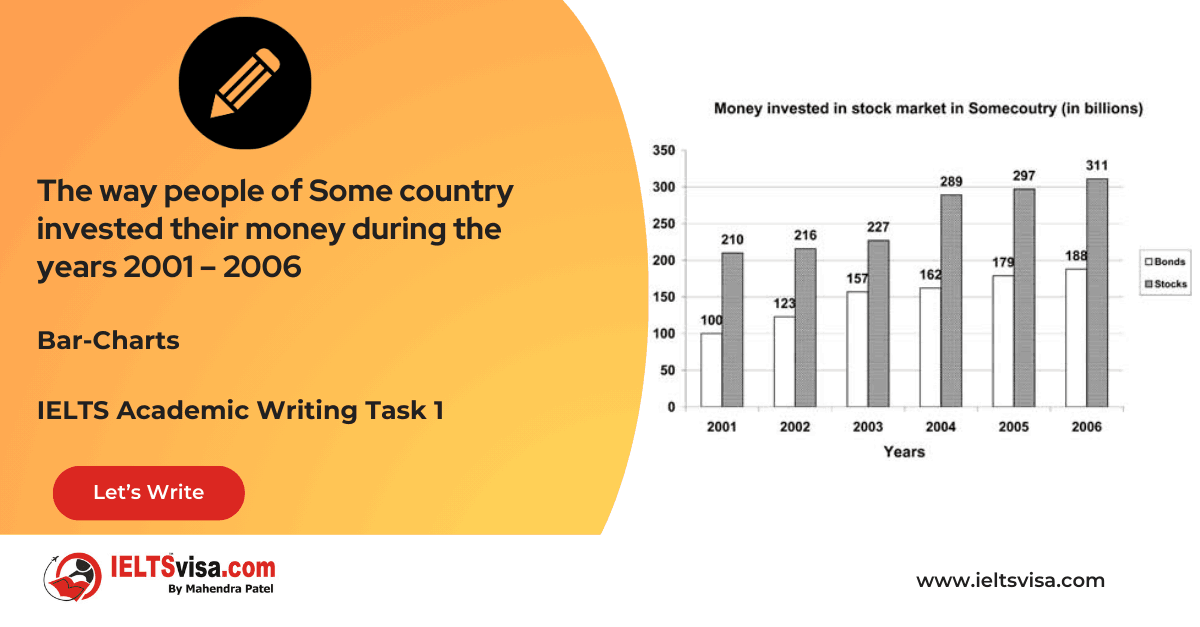The information and forecast about the vehicle numbers and CO2 emission in England and Wales between 2000 and 2020
IELTS Academic Writing Task 1 - Line Graph
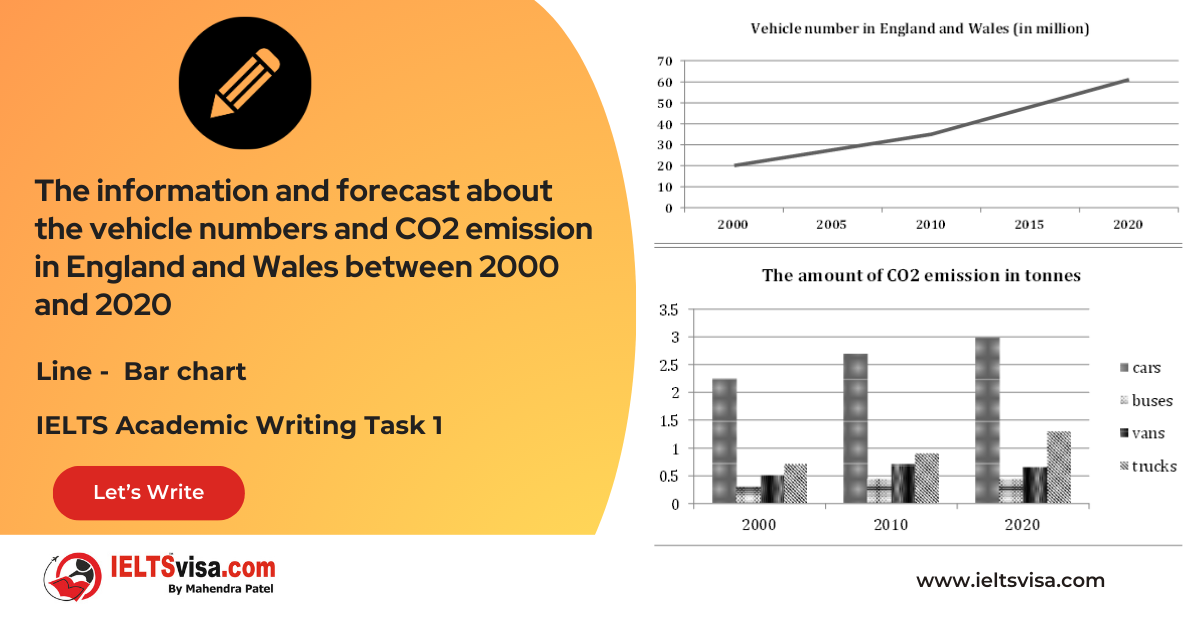
IELTS Writing Task 1 Question
The line graph and the bar chart give the information and forecast about the vehicle numbers and CO2 emission in England and Wales between 2000 and 2020. Summarize the information by selecting and reporting the main features and make comparisons where relevant.
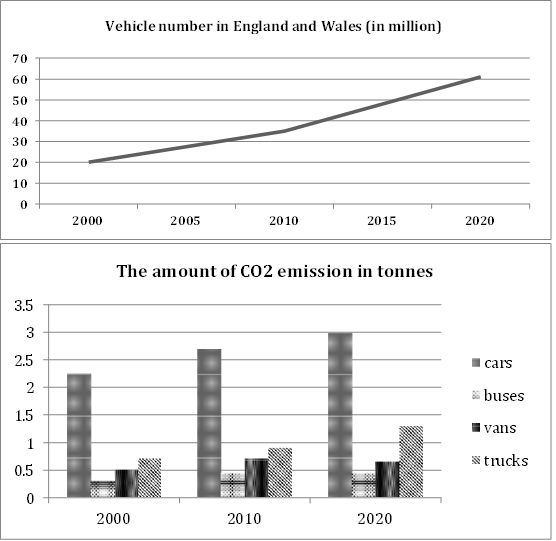
Common Questions for the Line Graph
1. Graph Type: Line Graph and Bar Chart
2. Title: Vehicle Numbers and CO2 Emissions in England and Wales (2000–2020)
3. What are the units of measurement?:
- Line Graph: Number of vehicles (in millions)
- Bar Chart: CO2 emissions (in tonnes)
4. Who: Vehicles in England and Wales
5. When: 2000 to 2020 (includes projections beyond 2010)
6. Where: England and Wales
7. Topic: Trends in vehicle numbers and CO2 emissions
Comparison Showing and Trends Any change over time (such as an increase or a decrease) is a trend.
Comparison 1 : Vehicle Numbers (Rapid Increase)
- Details:
1. Rose from 20 million in 2000 to 35 million by 2010.
2. Expected to surge to 60 million by 2020.
Comparison 2 : CO2 Emissions by Vehicle Type (Cars and Trucks Lead)
-
Details:
1. Cars: Largest source, increasing from 2 tonnes in 2000 to 3 tonnes by 2020.
2. Trucks: Second-highest, rising from 0.6 tonnes in 2000 to 1.3 tonnes by 2020.
Comparison 3 : Buses and Vans (Steady Emissions)
- Details:
1. Buses: Remain stable at 0.4 tonnes throughout the period.
2. Vans: Consistently emit around 0.6 tonnes of CO2.
Sample Answer
The line graph shows the number of vehicles in England and Wales from 2000 to 2020, while the bar chart illustrates CO2 emissions from different types of transport over the same period.
Overall, the rising number of vehicles is linked to escalating CO2 emissions, particularly from cars and trucks, while emissions from buses and vans are predicted to remain stable.
The number of vehicles increased steadily from 20 million in 2000 to 35 million by 2010 and is forecast to climb sharply to 60 million by 2020.
The bar chart highlights cars as the largest contributor to CO2 emissions, with emissions rising from 2 tonnes in 2000 to a predicted 3 tonnes by 2020. Trucks follow a similar upward trend, increasing from 0.6 tonnes in 2000 to 1.3 tonnes by 2020. In contrast, CO2 emissions from buses and vans are expected to remain steady throughout the period, at 0.4 and 0.6 tonnes, respectively.
Top 28 Vocabularies
| Vocabulary | Type | Meaning | Synonyms | Examples |
| Emission | Noun | The release of gas or substance into the air | Discharge, Output | Cars account for the largest CO2 emissions. |
| Surge | Verb/Noun | A rapid increase | Rise, Spike | Vehicle numbers are expected to surge by 2020. |
| Escalate | Verb | To increase or rise significantly | Intensify, Amplify | CO2 emissions are expected to escalate over time. |
| Steady | Adjective | Unchanging or constant | Stable, Unvarying | Emissions from buses remain steady at 0.4 tonnes. |
| Projection | Noun | A forecast or estimate for the future | Prediction, Forecast | Projections show an increase in vehicle numbers by 2020. |
| Illustrates | Verb | To show or explain something clearly | Depicts, Demonstrates | “The bar chart illustrates CO2 emissions from various transport modes.” |
| Link | Noun/Verb | A connection or relationship between two things | Connection, Correlation | “The rising number of vehicles is linked to increased CO2 emissions.” |
| Contributor | Noun | A factor or element causing something | Factor, Cause | “Cars are the largest contributor to CO2 emissions.” |
| Upward | Adjective | Increasing or moving higher | Rising, Ascending | “Trucks follow a similar upward trend in emissions.” |
| Forecast | Noun/Verb | A prediction of future events | Prediction, Estimate | “Vehicle numbers are forecast to climb sharply by 2020.” |
| Significant | Adjective | Important or noticeable | Notable, Substantial | “There is a significant increase in vehicle numbers.” |
| Transport | Noun | Modes of moving people or goods | Transit, Conveyance | “Different types of transport contribute varying levels of CO2 emissions.” |
| Increase | Verb | To grow or become larger | Rise, Expand | “The number of vehicles increased steadily over the period.” |
| Tonnes | Noun | Metric unit of weight, equal to 1,000 kilograms | Metric tons | “CO2 emissions from cars are predicted to reach 3 tonnes by 2020.” |
| Period | Noun | A span of time | Interval, Duration | “The data covers a period from 2000 to 2020.” |
| Gradual | Adjective | Happening slowly over time | Progressive, Steady | “The increase in vehicle numbers was gradual until 2010.” |
| Sharp | Adjective | Sudden and intense | Drastic, Sudden | “There is a sharp rise in vehicle numbers after 2010.” |
| Dominant | Adjective | Most important or influential | Leading, Prevailing | “Cars remain the dominant source of CO2 emissions.” |
| Remain | Verb | To stay in a particular state or condition | Stay, Persist | “Emissions from buses remain constant throughout the period.” |
| Stable | Adjective | Not changing or fluctuating | Steady, Fixed | “The level of CO2 emissions from vans remained stable over the years.” |
| Climb | Verb | To increase or rise gradually | Ascend, Grow | “Vehicle numbers are expected to climb sharply after 2010.” |
| Highlight | Verb | To emphasize or draw attention to something | Emphasize, Stress | “The bar chart highlights cars as the largest contributor to emissions.” |
| Consistent | Adjective | Acting or done in the same way over time | Uniform, Regular | “Buses showed consistent CO2 emissions across the period.” |
| Level | Noun | A specific amount or standard | Degree, Amount | “CO2 emissions from trucks increased to a higher level by 2020.” |
| Escalation | Noun | A rise in intensity or magnitude | Growth, Surge | “There is an escalation in emissions from trucks over the years.” |
| Anticipated | Adjective | Expected or predicted | Foreseen, Predicted | “An anticipated rise in vehicle numbers is shown by the graph.” |
| Impact | Noun | The effect or influence of something | Effect, Consequence | “The impact of more vehicles on emissions is evident in the graph.” |
| Peak | Noun/Verb | To reach the highest point | Summit, Maximum | “CO2 emissions from cars are predicted to peak at 3 tonnes by 2020.” |

Our Books
Master IELTS Speaking Part 1
IELTS Writing Task 1 Book
IELTS Writing Task 2 Book
Writing Task 1 Question Types
Practice IELTS Other Modules
IELTS Listening
The IELTS Listening test assesses how well you can understand spoken English in various contexts. It lasts about 30 minutes and is divided into four sections with a total of 40 questions. The listening tasks become increasingly difficult as the test progresses.
IELTS Academic Reading
The IELTS Academic Reading section assesses your ability to understand and interpret a variety of texts in academic settings. It is designed to evaluate a range of reading skills, including skimming for gist, reading for main ideas, reading for detail, understanding inferences, and recognizing a writer's opinions and arguments.
IELTS Speaking
The IELTS Speaking test assesses your ability to communicate in English on everyday topics. It lasts 11-14 minutes and consists of three parts: introduction, cue card, and a discussion based on the cue card topic.
IELTS General Reading
IELTS General Reading tests your ability to understand and interpret various types of texts. Here are some key areas and types of content you can expect to encounter in the reading section, along with tips for effective preparation.
IELTS Academic Writing Task 1
In IELTS Academic Writing Task 1, you are presented with a visual representation of information, such as graphs, charts, tables, or diagrams, and you are required to summarize, compare, or explain the data in your own words.
IELTS General Writing Task 1
In IELTS General Writing Task 1, you are required to write a letter based on a given situation. The letter can be formal, semi-formal, or informal, depending on the prompt. Here’s a breakdown of the key components to include in your letter
IELTS Academic Writing Task 2
In IELTS Academic Writing Task 2, you are required to write an essay in response to a question or topic. Here’s a guide to help you understand the essential elements of this task
IELTS Exam Tips
To succeed in the IELTS exam, practice regularly, familiarize yourself with the test format, improve your vocabulary, develop time management skills, and take mock tests to build confidence.
Grammer for IELTS
Grammar is the foundation of effective communication in English. Understanding tense usage, subject-verb agreement, and sentence structure enhances clarity and coherence in writing and speaking.
Vocabulary for IELTS
Vocabulary plays a crucial role in the IELTS (International English Language Testing System) exam, especially in the Speaking and Writing sections. Here’s an overview of why vocabulary is important and how it impacts your performance
RECENT IELTS SAMPLES QUESTIONS AND ANSWERS
Task 1 – Diagram – A conference hall built in 1981 and planned for 2020
20:00 Start Pause Stop [df_adh_heading title_infix="IELTS Writing Task 1 Question" use_divider="on"...
Task 1 – Table – The percentages of homeschooled students in Some Country in 1999-2004.
20:00 Start Pause Stop [df_adh_heading title_infix="IELTS Writing Task 1 Question" use_divider="on"...
Task 1 – Table – For a university tutor describing the information shown.
20:00 Start Pause Stop [df_adh_heading title_infix="IELTS Writing Task 1 Question" use_divider="on"...
Task 1 – Bar-Charts – The way people of Some country invested their money during the years 2001 – 2006
20:00 Start Pause Stop [df_adh_heading title_infix="IELTS Writing Task 1 Question" use_divider="on"...
Task 1 – Diagram – Rainwater Harvesting and Conversion to Drinking Water in an Australian Town.
20:00 Start Pause Stop [df_adh_heading title_infix="IELTS Writing Task 1 Question" use_divider="on"...
Task 1 – Column graph – Percentage of Young People Enrolled in Universities in 2000 and 2007.
20:00 Start Pause Stop [df_adh_heading title_infix="IELTS Writing Task 1 Question" use_divider="on"...

